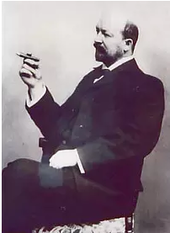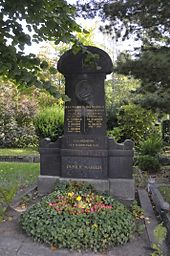Hugo Mairich
Hugo Mairich (born July 12, 1863 in Weißenfels ; † July 21, 1902 between Waltershausen and Laucha (traffic accident)) was a German civil engineer who worked as a water pipe and sewerage technician in the Thuringian city of Gotha .
Life
Hugo Mairich was born in White Rock, probably coincidentally the same place as Landgrave Balthasar under which the construction of major water supply for Gothaer Leinakanals in the years 1366-1369 was carried out, should make a significant contribution to the Mairich.
First Mairich completed an apprenticeship as a bricklayer , then studied at a polytechnic . Apparently he did not pass a state examination , which was the prerequisite for a conventional career as a construction clerk .
In 1882, the 19-year-old civil engineer Mairich got a job as a building supervisor in the office for sewer systems and street paving at the Gotha city administration. In 1888 the main market was paved at his instigation. In 1889 he was appointed office manager. Here he was in charge of extensive sewer and street paving work in Gotha. Mairich was a member of the Beautification Association and planned the goldfish pond on the Galberg in 1890 without a fee. In the same year he took over the position of director of the municipal waterworks founded in 1873, which at that time belonged to the municipal management for water supply and sewerage . The stock corporation for the water supply of the city of Gotha emerged from it. This company let spring water from the Mittelwassergrund (south of Tambach-Dietharz ) flow into an elevated tank on the Hirzberg between Wipperoda and Wannigsroda and in a closed pipe to Gotha.
The plans to transform the castle mountain and the construction of the waterworks and pumping station began Mairich already 1890. Mairichs plans provided for a system that the water of Leinakanals over fountains , fountains , waterfalls and swirls derives from the castle to the main market. In 1895, after the mountain mill that stood there and was built in 1387 was demolished in May , the new water art was built. It was inaugurated on October 15, 1895. In 1995 the facility was restored. In the basement of the Lucas-Cranach-Haus (Hauptmarkt 17) a pump and turbine system was installed by the Gotha company Briegleb & Hansen to operate the fountain and generate electricity. It is still in operation today.
As a water pipe and sewerage technician, Mairich was known beyond the city and state borders and worked on many, later award-winning hydraulic engineering systems. He was also a busy appraiser for water technology projects. He also accepted orders beyond the borders of Gotha and worked among other things. a. at the water supply facilities in Neustadt (Upper Silesia) , Fulda , Ohrdruf and Waltershausen .
In 1897 the ducal state ministry approved Mairich's draft for a better drinking water supply for the city of Gotha by building a reservoir near Tambach-Dietharz, the draft of which was presented to the city council as a dam plan in the same year and whose financial resources were approved. The city then acquired the 31 hectare area.
Mairich developed a project with all the necessary static calculations for the construction of the Tambach-Dietharz dam in the Thuringian Forest, but he did not live to see it being completed: On July 21, 1902, he had a fatal accident in a car accident on the road between Waltershausen and Laucha Buried in Gotha on July 24th.
The drinking water dam was built in the years 1902–1905 by the construction company Windschild & Langelott from Cossebaude and was inaugurated on July 7, 1906. It was the first dam in Thuringia and has a capacity of 775,000 m³.
Appreciation
As head of the municipal waterworks in Gotha, the engineer Hugo Mairich was a highly respected water pipe and sewerage technician, whom the trade journal Deutsche Bauzeitung recognized with a short obituary in 1902:
“Mairich was a so-called. self-made-man , (...) Unaffected by school opinions, he was a man of free creativity in a double sense, who knew how to handle and solve every task according to its characteristics. Just as he was always peculiar in the basic idea of solving a problem, he also paid the most painstaking care to all details and, unlike some specialists in his field, never let go of plans that bore the stamp of immaturity on their foreheads. "
Honors
- An early high point of his career was the award of the Cross of Merit 2nd Class by Duke Alfred in 1894 .
- In the sandstone of the Löwenbrunen on the upper main market in Gotha, an inscription reads Hugo Mairich fec [it] (lat. For: Hugo Mairich did it.)
- The city of Gotha honored its engineer Hugo Mairich by naming Mairichstraße, which connects Reinhardsbrunner with Leinastraße in western Gotha and leads over the Leinakanal.
- Every year since 2002 there has been a memorial service on the day of Mairich's death, which is organized by the Freundeskreis Leinakanal eV and the garden department of the city of Gotha.
- On August 10, 2016, the formerly commercial and technical vocational schools in Gotha were given the new name of the Hugo Mairich State Vocational School Center .
Web links
- Hugo Mairich (1863-1902) on the website of the City of Gotha, accessed on July 19, 2016
- The civil engineer Hugo Mairich - From his life and work on the website of the Freundeskreis Leinakanal eV, accessed on July 19, 2016
literature
- Helmut Roob, Günter Scheffler: Gotha personalities. Rhino-Verlag, Arnstadt / Weimar 2000, ISBN 3-932081-37-4 .
Individual evidence
- ^ Deutsche Bauzeitung , Volume 36, 1902, No. 62 (from August 2, 1902), p. 400.
| personal data | |
|---|---|
| SURNAME | Mairich, Hugo |
| BRIEF DESCRIPTION | German civil engineer |
| DATE OF BIRTH | July 12, 1863 |
| PLACE OF BIRTH | Weissenfels |
| DATE OF DEATH | July 21, 1902 |
| Place of death | Waltershausen |

